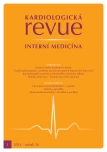Permanent cardiac pacing in terms of the new European recommendations from 2013
Authors:
P. Heinc; F. Kováčik; O. Moravec; J. Přeček; M. Táborský
Authors‘ workplace:
I. interní klinika – kardiologická FN Olomouc
Published in:
Kardiol Rev Int Med 2014, 16(1): 15-20
Category:
Cardiology Review
Overview
The new European recommendations in permanent cardiac pacing include a new classification of bradycardia indicated for permanent pacing according to inducing mechanism. For each type of bradycardia suggest the appropriate diagnostic method and the optimal mode of permanent stimulation. Optimal safety measures are proposed when a patient with an implanted pacemaker needs to undergo an magnetic resonance imaging.
Keywords:
bradycardia classification – diagnostics – optimal mode for permanent cardiostimulation – magnetic resonance
Sources
1. Brignole M, Menozzi C, Moya A et al. Pacemaker therapy in patiens with neurally mediated syncope and documented asystole: Third International Study on Syncope of Uncertain Etiology (ISSUE‑ 3): a randomized trial. Circulation 2012; 125: 2566– 2571. doi: 10.1161/ CIRCULATIONAHA.111.082313.
2. Wieling W, Thijs RD, van Dijk N et al. Symptoms and signs of syncope: a review of the link between physiology and clinical clues. Brain 2009; 132: 2630– 2642. doi: 10.1093/ brain/ awp179.
3. Menozzi C, Brignole M, Lolli G et al. Follow‑up of asystolic episodes in patients with cardioinhibitory, neurally mediated syncope and VVI pacemaker. Am J Cardiol 1993; 72: 1152– 1155.
4. Poole JE, Gleva MJ, Mela T et al. Complication rates associated with pacemaker or implantable cardioverter‑ defibrillator generator replacements and upgrade procedures: results from the REPLACE registry. Circulation 2010; 122: 1553– 1561. doi: 10.1161/ CIRCULATIONAHA.110.976076.
5. Epstein AE, DiMarco JP, Ellenbogen KA et al. 2012 ACCF/ AHA/ HRS focused update incorporated into the ACCF/ AHA/ HRS 2008 guidelines for device‑based therapy of cardiac rhythm abnormalities: a report of the American College of Cardiology Foundation/ American Heart Association Task Force on Practice Guidelines and the Heart Rhythm Society. J Am Coll Cardiol 2013; 61: e6– e75. doi: 10.1016/ j.jacc.2012.11.007.
6. Nielsen JC, Thomsen PE, Højberg S et al. A comparison of single‑lead atrial pacing with dual chamber pacing in sick sinus syndrome. Eur Heart J 2011; 32: 686– 696. doi: 10.1093/ eurheartj/ ehr022.
7. Sweeney MO, Bank AJ, Nsah E et al. Minimizing ventricular pacing to reduce atrial fibrillation in sinus‑ node disease. N Engl J Med 2007; 357: 1000– 1008.
8. Wilkoff BL, Cook JR, Epstein AE et al. Dual‑ chamber pacing or ventricular backup pacing in patients with an implantable defibrillator: the Dual Chamber and VVI Implantable Defibrillator (DAVID) Trial. JAMA 2002; 288: 3115– 3123.
9. Padeletti L, Pieragnoli P, Di Biase L et al. Is a dual‑ sensor pacemaker appropriate in patients with sino‑ atrial disease? Results from the DUSISLOG study. Pacing Clin Electrophysiol 2006; 29: 34– 40.
10. Sulke N, Chambers J, Dritsas A et al. A randomized double‑blind crossover comparison of four rate‑ responsive pacing modes. J Am Coll Cardiol 1991; 17: 696– 706.
11. Castelnuovo E, Stein K, Pitt M et al. The effectiveness and costeffectiveness of dual‑ chamber pacemakers compared with single‑chamber pacemakers for bradycardia due to atrioventricular block or sick sinus syndrome: systematic review and economic evaluation. Health Technol Assess 2005; 9: iii, xi– xiii, 1– 246.
12. Healey JS, Toff WD, Lamas GA et al. Cardiovascular outcomes with atrial‑based pacing compared with ventricular pacing: meta‑analysis of randomized trials, using individual patient data. Circulation 2006; 114: 11– 17.
13. Connolly SJ, Kerr CR, Gent M et al. Effects of physiologic pacing versus ventricular pacing on the risk of stroke and death due to cardiovascular causes. Canadian Trial of Physiologic Pacing Investigators. N Engl J Med 2000; 342: 1385– 1391.
14. Lamas GA, Orav EJ, Stambler BS et al. Quality of life and clinical outcomes in elderly patients treated with ventricular pacing as compared with dual‑ chamber pacing. Pacemaker Selection in the Elderly Investigators. N Engl J Med 1998; 338: 1097– 1104.
15. Toff WD, Camm AJ, Skehan JD. Single‑chamber versus dual‑ chamber pacing for high‑grade atrioventricular block. N Engl J Med 2005; 353: 145– 155.
16. Lau CP, Rushby J, Leigh‑Jones M et al. Symptomatology and quality of life in patients with rate‑ responsive pacemakers: a double‑blind, randomized, crossover study. Clin Cardiol 1989; 12: 505– 512.
17. Leung SK, Lau CP. Developments in sensor‑driven pacing. Cardiol Clin 2000; 18: 113– 155, ix.
18. Oto MA, Muderrisoglu H, Ozin MB et al. Quality of life in patients with rate responsive pacemakers: a randomized, cross‑ over study. Pacing Clin Electrophysiol 1991; 14: 800– 806.
19. Connolly SJ, Sheldon R, Thorpe KE et al. Pacemaker therapy for prevention of syncope in patiens with recurrent severe vasovagal syncope: Second Vasovagal Pacemaker Study (VPS II): a randomized trial. JAMA 2003; 289: 2224– 2229.
20. Raviele A, Giada F, Menozzi C et al. A randomized, double‑blind, placebo‑ controlled study of permanent cardiac pacing for the treatment of recurrent tilt‑induced vasovagal syncope. The vasovagal syncope and pacing trial (SYNPACE). Eur Heart J 2004; 25: 1741– 1748.
21. Irnich W. Risks to pacemaker patients undergoing magnetic resonance imaging examinations. Europace 2010; 12: 918– 920. doi: 10.1093/ europace/ euq144.
22. Wilkoff BL, Bello D, Taborsky M et al. Magnetic resonance imaging in patients with a pacemaker system designed for the magnetic resonance environment. Heart Rhythm 2011; 8: 65– 73. doi: 10.1016/ j.hrthm.2010.10.002.
Labels
Paediatric cardiology Internal medicine Cardiac surgery CardiologyArticle was published in
Cardiology Review

2014 Issue 1
Most read in this issue
- Acute kidney injury
- Selected renal diseases in pregnancy
- Rapidly progressive glomerulonephritides (crescentic glomerulonephritides)
- Drug therapy in chronic kidney disease
